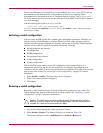
Switch Manager
74 HP StorageWorks 2/8q Fibre Channel Switch Management User Guide
SNMP Trap Configuration
The SNMP trap configuration defines how traps are set. Choose from the tabs Trap1 – Trap 5
to configure each trap. Table 17 describes the SNMP configuration parameters.
Remote Logging parameter
The Remote Logging (syslog) parameter enables saving of the log information to a remote
host that supports the syslog protocol. When enabled, the log entries are sent to the syslog host
at the IP address entered in the Logging Host IP Address box. Log entries are saved in the
internal switch log whether this feature is enabled or not.
Location Specifies the name (up to 64 characters) for the switch
location.
The default is “undefined”.
Authentication Trap Enables or disables the reporting of SNMP authentication
failures. If enabled, a notification trap is sent when incorrect
community string values are used.
The default is “False”.
Write Community Write community password (up to 32 characters) that
authorizes an SNMP agent to write information to the switch.
This is a write-only box. The value on the switch and the
SNMP management server must be the same.
The default is “private”.
Table 17: SNMP trap configuration parameters
Parameter Description
Trap Version Specifies the SNMP version (1 or 2) with which to format traps.
Trap 1 Enabled Enables or disables the trap.
If disabled, traps are not configurable.
Trap Address* Specifies the IP address to which SNMP traps are sent.
A maximum of 5 trap addresses are supported.
The default address for trap 1 is 10.0.0.254.
The default address for traps 2–5 is 0.0.0.0.
Trap Port* The port number on which the trap is sent.
The default is 162.
Trap Severity Specifies a severity level to assign to the trap.
Open the menu and choose a level. The Trap 1 Enabled check box on
the Network Properties dialog box must be enabled to access this
menu.
Trap severity levels include Unknown, Emergency, Alert, Critical,
Error, Warning, Notify, Info, Debug, and Mark.
* Trap address (other than 0.0.0.0) and trap port combinations must be unique. For example, if
trap 1 and trap 2 have the same address, they must have different port values. Similarly, if trap
1 and 2 have the same port value, they must have different addresses.
Table 16: SNMP Configuration parameter (Continued)
Parameter Description


















